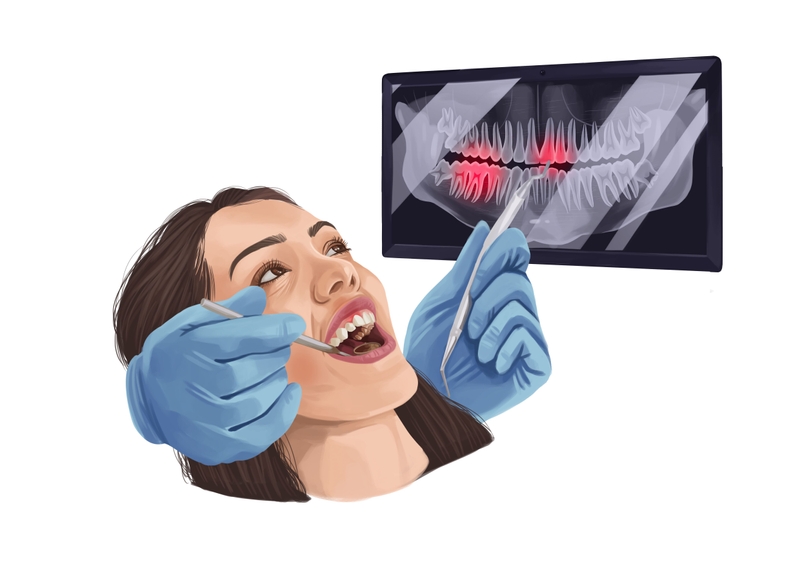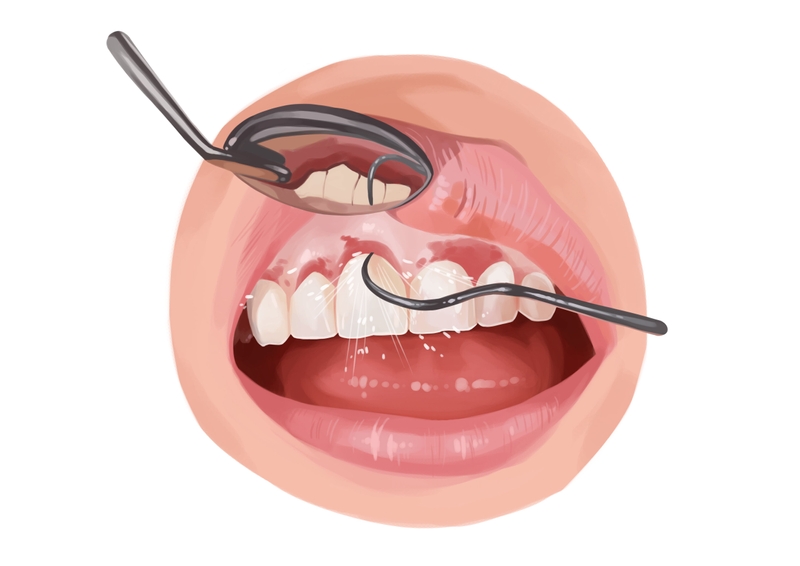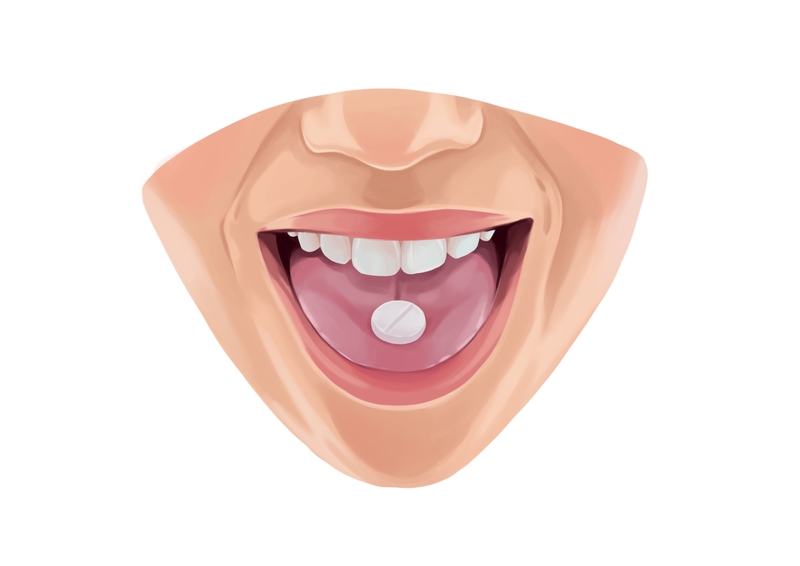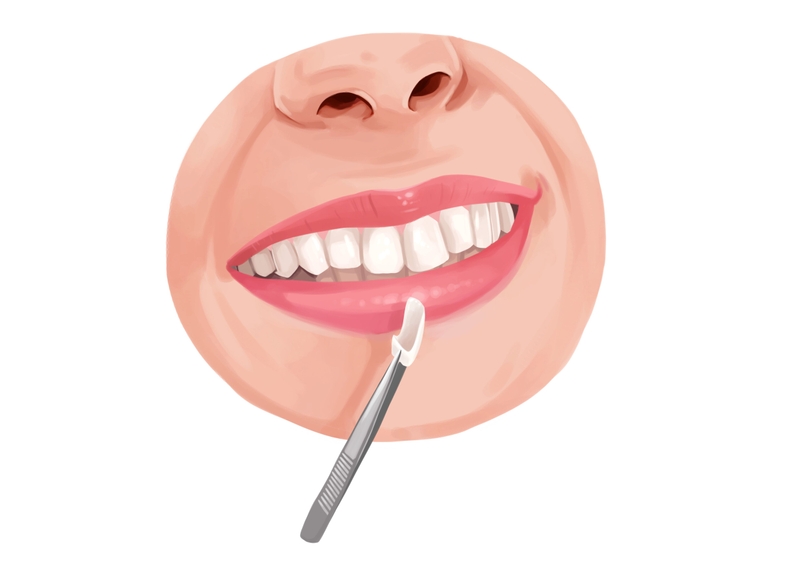- Gum recession or gingival recession is a process in which soft tissues pull back from the teeth. Gum recession exposes more of the dentition.
- Receding gums make the mouth more susceptible to diseases such as gum disease and can be painful. Genetics, oral hygiene, tobacco use, teeth grinding or clenching, aggressive brushing, and gum disease are all causes of this condition.
- Treatment of gum recession depends on the stage of progression of the problem. It may include a thorough cleaning, medication or surgery.
Need urgent help with receding gums? Find a dentist open nearby with Authority Dental.
Have your teeth become too sensitive near the gum line? Here's everything you need to know.
Symptoms of receding gums

Picture by Authority Dental under CC 2.0 license
Gums are in your mouth to protect your roots, keep your teeth in place, and provide a barrier against bacteria. When they begin to recede, you may experience a plethora of dental issues. It’s best to catch the problem early in order to prevent lasting damage.
The most common signs of receding gums include:
exposed tooth roots,
teeth looking longer than before, or being able to see the margins on crowns,
gums appearing “frayed” near the edges,
bleeding when you are brushing,
red or swollen gums,
changes to the bite,
pain, and
The first thing you can usually notice is sensitivity to hot and cold foods and drinks. This is because tooth roots become exposed. Instead of hard dentin, they are covered with cementum, which is a lot more vulnerable to stimuli.
Receding gums are also associated with pain when biting or chewing or even when you are brushing your teeth. It is not uncommon to see redness in the toothpaste you spit out. It might be more and more difficult to combat bad breath, as bacteria accumulate in the pockets formed between the gums and teeth.
Often, it is easy to notice that your gums have changed shape. This means the problem is already severe and you should seek treatment.
What causes receding gums?
Receding gums are usually caused by a mixture of the following:
Periodontal disease
The main cause of gum recession is periodontal disease. This is a bacterial infection of the gums and supporting structures in the jaws. Periodontal pockets can become very deep and teeth may start to feel loose.
Genetics
Some people are more susceptible to gum recession and disease due to genetics. About 30% of the US population might have a predisposition to gum issues, no matter how well they take care of their mouths.
Aggressive brushing or poor oral hygiene
If you brush your teeth incorrectly, too hard, or with inappropriate products, you can easily damage your gums. If you feel tenderness after brushing, switch to a soft-bristled brush and a paste with little or no irritating ingredients. Whitening products are not recommended for those with sensitive gums.
Gums tend to begin receding on the left part of the mouth, around the outside of the arch. This is because most people are right-handed and put the most pressure on that area while brushing. If this is the case, it's time to think about learning to brush more gently. Using electric toothbrushes also can help, as their vibrating or rotating action is much gentler than hard brushing back and forth.
This doesn’t mean you should neglect to clean your mouth. Those who don’t brush and floss every day and miss out on bi-yearly dental cleanings are also at higher risk of gum recession.
Hormones
Women are particularly prone to gum issues due to hormonal changes. Puberty, pregnancy, and menopause are all periods in a woman’s life when gum recession is more likely.
Tobacco
Any products containing tobacco and nicotine are hard on the soft tissues in your mouth. Plaque is also more likely to stick to your teeth if you chew tobacco.
Grinding and orthodontic issues
Clenching and grinding your teeth, crooked dentition, and misaligned bites all work towards putting extra pressure on your gums. If you believe orthodontic issues are a problem, report to a specialist. The more teeth shift, the more tissue you may lose.
Age
A big risk factor for gum loss is age. Many people over 60 have some stage of gum recession around at least one tooth.
Certain diseases
Several medical conditions such as diabetes and HIV also increase the risk of developing gum recession. Drugs like antidepressants can also lead to dry mouth.
Foreign objects
Ill-fitting dentures can irritate the gums and cause recession as well. The same goes for any foreign objects in the mouth like lip and tongue piercings. However, when it comes to piercings, there is no difference if they fit well. Just their presence can cause gum recession.
How to fix receding gums?
Treatment for receding gums depends on the stage of progression of the issue. It can be diagnosed during dental exams. The dentist uses a probe to measure your gum pockets. The National Institute of Dental and Craniofacial Research states that those should range between 1 and 3 mm. Any larger pocket size indicates a problem.
This can also be performed by a dental nurse or hygienist before a prophy. The process of receding gums takes a long time, but it’s still best to catch it early on. Don’t neglect regular visits to the dental office. Your dentist may also refer you to a periodontist.
Scaling and root planing

Picture by Authority Dental under CC 2.0 license
The first step of receding gums treatment is often to perform a deep clean. Plaque and tartar buildup is removed from the surface of the teeth with the help of an ultrasonic device. The dentist then cleans exposed root surfaces to allow gums to shrink back and reattach.
If the problem is severe, especially if gums have receded by a lot, this might not be enough.
Medication

Picture by Authority Dental under CC 2.0 license
Prescribed medication can help to fix receding gums. This usually takes the form of time-release antibiotics placed or injected directly into your soft tissues. If the problem is not severe, other options include:
topical antibiotic gel,
antiseptics chips,
antimicrobial mouthwash, or
enzyme suppressants.
Desensitizing agents may be placed on exposed root surfaces to minimize sensitivity.
Receding gums surgery
Surgery is likely to be recommended if the bone surrounding teeth was lost.
The simplest form of surgery performed to fix receding gums is open-flap scaling and root planing. It is similar to what was described above, except an incision is made in the soft tissue to “open” it. The infection is removed and gums are stitched back together.
If the bone was lost, the periodontist might place regenerative material under the gum before the final step. This is usually a tissue-stimulating protein or graft tissue (sourced from another part of your mouth).
The latter is often referred to as a soft tissue graft. The source material is often the roof of the mouth. This can be done with synthetic materials, such as gum-colored resin. This will only cover the gaps and the body will not regenerate any tissue.
Cosmetic dentistry

Picture by Authority Dental under CC 2.0 license
Sometimes when tissue is lost, aesthetics suffer. In such a case, your dentist might recommend removable gum veneers or orthodontic intervention. Another option to cover areas with notching or sensitivity is composite bonding. Exposed root surfaces are prone to decay and fillings may be required to address the issue.
Veneers are made from acrylic or silicone and work much like a removable denture.
Orthodontics can help move teeth to a position that makes your mouth look more uniform. This is also recommended if the positioning of your dentition makes it hard to clean or makes it easy for deep periodontal pockets to form.
How to prevent receding gums?
There aren’t many natural remedies for receding gums, but you can take preventive measures. These include excellent oral hygiene and changes to your diet and habits.
Brush your teeth with a soft-bristled toothbrush. Floss your teeth at least once a day. Stay up-to-date with your dental visits. If you had gum recession or periodontitis before, you may have to visit a dentist or periodontist more than twice a year.
Think about investing in antimicrobial mouthwash. You can also use a saltwater rinse.
Quit smoking and binge drinking, as such habits make your entire mouth more vulnerable to diseases and infections.
Try to incorporate foods that promote gum health into your diet, including:
nuts and seeds,
salmon and fatty fish,
cacao,
green tea,
bell peppers, and
fermented foods such as kimchi or sauerkraut.
FAQ
Can receding gums be reversed?
Will my teeth fall out from receding gums?
How much does it cost to fix receding gums?
Is gum recession surgery painful?
Peter March, DDS
Gum grafting will not attach to composite. If there is no decay a gingival graft may be a better solution to cover the exposed areas. Many times the bonding can be placed without an anesthetic.